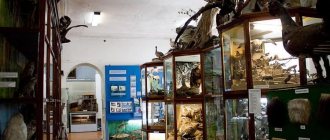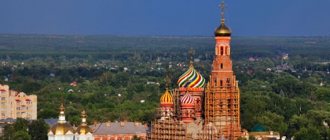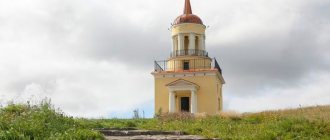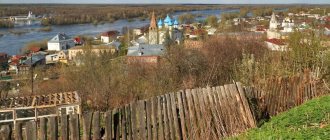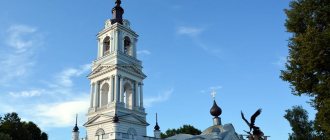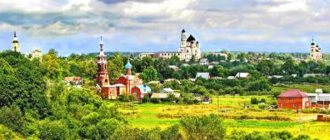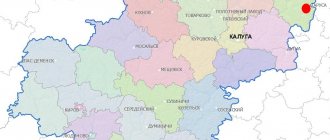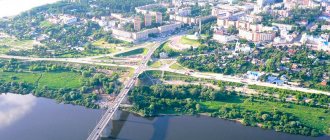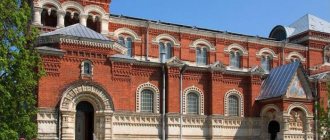Mentions of the city of Mozhaisk appear in chronicles for the first time in 1231, but it began its existence much earlier. Mozhaisk was a fortress of the Moscow principality on its western borders.
At one time, Mozhaisk was the largest religious center of Muscovy and consisted of 40 streets, 15 settlements, 16 monasteries, 75 churches and 400 shops. The city was the residence of the great princes - Vasily III, Ivan the Terrible, Boris Godunov. Little has remained of its former splendor, but the city still has interesting places worth visiting.
On the way to Mozhaisk you can stop by several interesting places - Vereya, the Pushkin Museum-Reserve and others - all of them are marked on the map in the article about the sights of the Moscow region.
At the same time, Mozhaisk is located practically on the border of the Smolensk region - there are even more interesting places and cities there.
Streets of Mozhaisk
The streets of Mozhaisk today look the same as they did a century ago. The central street of Mozhaisk is Moskovskaya , into which the Minskoye Highway goes. All the main city administrative buildings are located on it, as well as beautiful recreational areas - Leninsky and Bagrationovsky squares .
Borodinskaya Street is interesting for its architectural buildings of past centuries.
A walk along Sergei Gerasimov will take you to the Luzhetsky Monastery, past the house of the famous artist, after whom it is named.
Luzhetsky Monastery
Address: st. Gerasimova, 1 Phone: Website: luzh-mon.ru Opening hours: daily from 9:00 to 17:00 Cost: it is customary to leave donations at the entrance
This is the attraction that you first pay attention to when entering Mozhaisk. It was founded by Saint Ferapont Belozersky in 1408. Located on a high hill on the outskirts of the city, the Luzhetsky Monastery is the only one of the 18 monasteries that existed throughout the history of the city that has survived to the present day. Saint Ferapon lived in the monastery all his life and was buried near its walls. It is the relics of the saint that attract a large number of pilgrims to the walls of the monastery.
During the War of 1812, the monastery burned down several times. Many buildings were burned and looted, but later the Luzhetsky Monastery was restored. Now the monastery is a source of spiritual life and a place that has preserved the history of centuries.
On one side of the monastery there is a birch alley and a pond, on the other - the holy spring of Ferapont, a font and a chapel.
Museum-reserve "Borodino Field"
An acquaintance with Mozhaisk would not be complete without a visit to the Borodino Field military-historical museum-reserve.
It was created back in 1839 and covers an area of more than 109 km2. The famous Battle of Borodino between Kutuzov’s army and the troops of Napoleon Bonaparte took place in this place in August 1812. And in October 1941, the defense line passed there during the German offensive on Moscow.
The museum-reserve includes:
- main building;
- palace and park ensemble;
- Spaso-Borodinsky Monastery;
- Abbess Maria's house.
Spaso-Borodinsky Monastery
On the site of the main museum building in the center of the field, there was previously a small gatehouse built on the orders of Nicholas I. Two war veterans looked after the main monument and Bagration’s burial place. The house contained a map of the Borodino field and items found on the battlefield.
The main monument to Russian soldiers was erected with the participation of Prince Alexander Nikolaevich, who laid the first stone. True, the first monument was destroyed in 1932, but later it was restored. The same materials were used - bronze with gilding and cast iron.
At Borodino Field, visitors get acquainted with:
- monument to Kutuzov;
- burials of Bagration and Tatishchev;
- mass graves, burials of Russian officers;
- artillery fortifications: Shevardinsky redoubt, Raevsky battery;
- bots, trenches, anti-tank ditches;
- current exhibitions.
There are 50 memorials on the field. It’s impossible to see it all at once. They are separated by a considerable distance. Their location is shown on the field map.
The first Sunday of September is the annual day of the Borodin Day holiday with colorful shows. On them, viewers can imagine the events of those days, seeing soldiers dressed in Russian and French uniforms, hussars on horseback and hearing the roar of cannons.
Borodin Day. (Reconstruction of the battle)
House-museum of the artist S.V. Gerasimov
Address: st. Gerasimova, 2 Telephone: Opening hours: daily from 9:00 to 17:00, except Monday and the last Friday of the month Cost: 200 rubles
In a small park next to the Luzhetsky Monastery there is a two-story house in which the famous artist S.V. Gerasimov created his works. With the rank of academician, he headed the Union of Artists of the USSR for a long time.
Now the house serves as a museum, where the works of the outstanding master, as well as his personal belongings, are collected. Here you can see the artist’s paintings, glorifying the beauty of his native Mozhaisk region and graphic works, of which the museum houses more than 450.
Mozhaisk Sea
Address: village of Marfin Brod (8 km northwest of Mozhaisk) Getting there: by car (21 minutes travel)
The largest reservoir in the Moscow region, called the Mozhaisk Sea because of its size, was built in 1960 near the source of the Moscow River. Through this reservoir, the river flow is regulated and the possibility of floods in the capital is eliminated.
For fishermen, the reservoir has become a real paradise. Even a novice fisherman can catch bream, carp, pike perch and eel here.
History of conferring the honorary title “City of Military Glory”
Mozhaisk is a city in the west of the Moscow region, the administrative center of the Mozhaisk district and the urban settlement of Mozhaisk.
Mozhaisk is closely connected with the events of the Great Patriotic War of 1941-1945.
The fighting in the Mozhaisk direction is an integral part of the Moscow strategic defensive operation (from September 30 to December 5, 1941). Its main goal was to disrupt the offensive of the German Army Group Center with the goal of capturing Moscow (Operation Typhoon).
Here the construction of the Mozhaisk defense line with a length of 220 km was carried out, which was the main defensive line on the western approaches to Moscow. The defense line was built by decision of the State Defense Committee and Headquarters from the end of July and, practically, before the start of fighting in October 1941. According to some information, the line was completed after the winter counter-offensive of the Red Army, until the fall of 1942.
The main defensive line was located at a distance of 120-150 km from Moscow, along an arc from north to south, from the Ivankovo reservoir on the Volga River, along the Lama River, further west of Volokolamsk and Mozhaisk, almost to Kaluga. The main zone included four main fortified areas (UR) - Volokolamsk, Mozhaisk, Maloyaroslavets and Kaluga, each of which consisted of 10-15 battalion defense areas (BRO).
By October 10, 1941, by the time the Nazi troops entered the defense line, the construction of the fortifications was very far from completion. The readiness for long-term structures in different SDs was different, but everywhere it was less than 50%. Anti-tank obstacles and field defensive structures were more ready, but, absolutely everywhere, construction was not completed. And, more importantly, even long-term structures, in the overwhelming majority, were not armed, and there were not enough weapons for them
From October 12 to October 18, 1941, stubborn battles with fascist troops took place near Mozhaisk. During the occupation, partisan detachments operated in the area. After the encirclement of part of the forces of the Western, Reserve and Bryansk fronts in the Vyazma region, there was a threat of a breakthrough of German troops in the Moscow direction, but Soviet troops, inferior to the enemy in numbers, offered him stubborn resistance in the Mozhaisk direction, bled him out and stopped his strike forces by the end of October, which they were never able to break through the new defensive front created on the Mozhaisk line.
Novo-Nikolsky Cathedral
Address: st. Borodinskaya, 8 Opening hours: from 9:00 to 17:00 daily Cost: donations in the amount of 100 rubles
The most unusual attraction of Mozhaisk is the Novo-Nikolsky Cathedral, located on a hill. Its construction began on the site of the stone Mozhaisk Kremlin in 1779 and lasted until 1812. The facade of the building contains elements and signs of pseudo-Gothic style, unusual for the Moscow region. Next to Novo-Nikolsky is the Old Nikolsky Cathedral, founded in the 14th-15th centuries.
The decoration and shape of the buildings indicate that the appearance of the cathedral is associated with the Masonic order.
Sights of Mozhaisk and its surroundings
Religious buildings in Mozhaisk
- One of the most beautiful and impressive, if we talk about architecture, is the Mozhaisk Luzhetsky Ferapontov Bogoroditsky Monastery , dating back to 1408 . It is the only monastery that has survived to this day. (By the way, initially there were as many as 18 such monasteries in Mozhaisk).
- On the territory of the monastery you can see several architectural monuments, the most ancient of which are the Cathedral of the Nativity of the Blessed Virgin Mary and the bell tower with the tomb of the Savelov family . The Novo-Nikolsky Cathedral is located on the territory of the Mozhaisk Kremlin and is visible to the naked eye from almost anywhere in the city. The cathedral is originally Orthodox, although it looks like a Gothic castle from the early 15th century.
Construction took place in very difficult times for Russia: from 1802 to 1814.
However, construction was completed and the cathedral operated for many years. By the way, it was here that until 1919 the relics of St. Sergius of Radonezh, the blessed Prince Vladimir and other holy martyrs were kept. Over time, the relics, like many other artifacts, disappeared without a trace. Today the cathedral is open and functioning. No less famous:
- Spaso-Borodinsky Convent;
- Kolotsky Monastery;
- Church of Demetrius of Thessalonica;
- Church of the Smolensk Icon of the Mother of God;
- The Cathedral of the Vladimir Icon of the Mother of God is not in Mozhaisk itself, but in its environs.
Historical heritage and city monuments in the city of Mozhaisk
- Porechye estate (or former estate of the Uvarovs). The main house, which looks like a palace, was built in 1830 . The estate, by then and by today’s standards, was rich and luxurious. The estate was famous for its rich collections of paintings, literature and art. Unfortunately, much has not survived to this day. Some were looted, some were destroyed. What was saved was given to historical museums in Moscow. The estate itself has been restored many times. Today there is a private sanatorium here, and the estate is closed to idle tourists.
- The Varzhenevsky estate is located 7 km from Mozhaisk. Unfortunately, the estate itself (founded in 1674) and the wooden church have not survived. But in excellent condition there is a picturesque linden park with small islands and a pond. Suitable for a quiet family vacation or for themed photo shoots, which are especially popular now. Don't forget to bring something to snack with!
- Built at the beginning of the 20th century, the Khlebnikov-Rolle City Estate . The estate is located in one of the central city blocks, it will not be difficult to find it. The main house with a terrace and staircase and a small garden with a metal fence have been preserved here. However, due to lack of funding, the mansion is now going through hard times. Therefore, have time to capture a piece of our history before it is completely undermined by time and financial issues.
City estate of Khlebnikov-Rolle
Just like temples, many estates are scattered throughout the Mozhaisk district, and you will have to get to them. (Usually this is no more than 10-20 km). But it is worth taking into account that many of them have not survived, and in their place you will find only picturesque parks and a small reminder of the past in the form of the remains of fences or dilapidated gates.
- And by the way, if you decide to go to Mozhaisk in the spring, then on the eve of the most patriotic holiday be sure to visit the military monuments: the “City of Military Glory” stele (near DS Bagration), the “Eternal Flame” stele and the monument to the soldier-liberator on Komsomolskaya Square.
- There are also several local history and local history museums in Mozhaisk: the House-Museum of the artist S.V. Gerasimov and the Mozhaisk Museum of History and Local Lore . (Be sure to check the opening hours of museums in advance; they may be under reconstruction).
Natural attractions and recreational areas
Mozhaisk can be an excellent summer holiday destination for the whole family. One of the most picturesque places is the shore of the Mozhaisk reservoir .
And don’t let the “technical” name of the reservoir scare you, you can swim here no worse than in the sea.
It's just a lot less work to get there. a yacht club on the territory .
If you are not a member of the club and you don’t have a yacht either, it doesn’t matter. Regular excursions on a yacht around the reservoir are organized here especially for tourists. You can swim privately, or you can organize a whole group. Good news for avid fishermen - carp, bream, pike perch and eel are splashing in the pond. Fishing will be great! If you decide to come here not only for the weekend, but to stay in Mozhaisk for a week or two, you can book a room in a boarding house or sanatorium. There are also recreation centers here. During their existence, they have all proven themselves well and managed to gain fans in the form of regular customers. (Please check availability and cost in advance!)
In addition to water treatments, horseback riding organized by the Outpost equestrian tourist base . The routes, depending on the wishes of vacationers and the physical capabilities of the animals, can be adjusted in duration. There are also thematic programs here. And don't forget about walking! Clean air and truly beautiful landscapes will make any vacation unforgettable!
Museum-reserve "Borodino Field"
Almost in the first days of September, Mozhaisk experiences the largest influx of tourists and vacationers. Everyone, as in the memorable 1812, strives to get to the Borodino field , where a real battle is being played out with a reconstruction of the main military episodes of the battle.
This is not just a crowd of people, but a well-organized event, for which they prepare in advance: they sew suits, learn military regulations, formation rules and methods of combat of that time. If you are not a member of the military history club, then you can just be a spectator. The impressions will be no less strong than those of the direct participants, rest assured! By the way, don’t be surprised if you hear foreign speech next to you. “Borodin Day” is a fairly well-known event, and military personnel from near and far abroad come to participate in it.
The only thing is, perhaps, it is better not to go here with very young children - such a crowd and colossal noise can frighten the kids.
If you didn’t manage to get to the holiday directly, don’t be upset. You can visit all the most iconic places on your own. Be sure to go up to the Raevsky battery , where the main monument to the heroes of the Battle of Borodino , and also do not forget to appreciate the majesty of the monument at the command post of M. I. Kutuzov and the monument at the command post of Napoleon .
By the way, here on the territory of the former battle there is
the State Borodino Military Historical Museum-Reserve . Several types of excursions can be arranged for you (your choice). You can choose a bus tour, during which you will go to explore the field (where historical elements of the battles are partially preserved) and several exhibitions.
For children, the excursion is carried out with elements of a game and a kind of quest: the children are invited to try on a uniform or other equipment, and remember the famous work of M. Yu. Lermontov. There is also a pedestrian version (it is somewhat shorter, but no less interesting), designed to visit one exhibition and explore the field from the Raevsky battery, which offers an excellent view.
What to see in Mozhaisk in 1 day of stay for a tourist
Of course, one day will clearly not be enough to see all the sights of the city of military glory. And yet, if you only have this one day, be sure to visit:
- Mozhaisky Luzhetsky Ferapontov Bogoroditsky Monastery;
- Monument to the soldier-liberator on Komsomolskaya Square.
- House-Museum of the artist S. V. Gerasimov;
- Novo-Nikolsky Cathedral;
- Stele “City of Military Glory” (opened in 2015);
You simply don’t have enough time for other attractions. If you do not have your own car, during your trip, use the services of local carriers (buses or taxis). You will have to walk a lot, and you will most likely get tired. If you get hungry, the city has many cafes and restaurants serving a variety of European, Oriental and Caucasian cuisine. In general, for every taste, as they say.
Khlebnikov-Rolle Estate
Address: st. Red Partisans, 15-17
The Khlebnikov-Rolle estate, built in the Art Nouveau style in the first half of the 20th century, is located in the center of Mozhaisk. It is a house with eclectic and modern elements behind a metal fence with a small garden. All facades of the building are individual, which gives special solidity to the building as a whole. However, the building looks abandoned.
Currently there are no excursions to the estate.
Estates of famous Russian families
In Mozhaisk and its environs, many estates of historical value have been preserved.
Along Red Partisan Street, 15/17 you can see the Khlebnikov-Rolle estate
The main house of the estate is a one-story brick building with decorations on the facades of projections and projections. This site was owned by the French merchant Rolle. He ordered to add a terrace with a staircase around the house (now it is almost destroyed), and to enclose the area with a carved metal fence. There is an orchard near the terrace.
Rolle had 10 children. Each child was given a separate flowerbed. The children enjoyed looking after plants and breeding new species. Exotic plants are still found in the garden.
Interesting fact. It was assumed that Emperor Nicholas II would stop at this estate on his way to celebrate the 100th anniversary of the Battle of Borodino. But the emperor’s plans changed; he used a specially built railway line.
The estate was sold to the merchant Disan Khlebnikov. He didn't live there long. After the revolution, he left the country. Visited the building:
- military registration and enlistment office;
- Committee of the All-Union Communist Party (b);
- during the war, partisan detachments were created in it;
- Komsomol district committee;
- then the Department of Agriculture.
The ownership of the mansion is controversial. There are historians who believe that this house was built by Khlebnikov for the arrival of the emperor. The Rolle estate was located opposite and has not survived. And the confusion occurs because of the same address - at the intersection of Bolshoy Afanasyevsky and Sretenskaya streets.
After the agricultural department moved to another building, the estate was empty and survived two fires. The garden no longer contains the large exotic trees brought by Rolle from other countries.
20 km from Mozhaisk in the village of Goretovo there is an estate of the 18th century, which at different periods was visited by:
- Musin-Pushkin (founder of the estate);
- Bestuzhev-Ryumin (was in exile);
- Volkonsky.
The estate reached its greatest prosperity under the Volkonskys. In addition to the two-story house, the estate had: a church, a greenhouse with greenhouses, orchards and even factories - a brick factory, a tannery and a distillery.
Estate in the village of Goretovo
On the territory there are preserved: a two-story outbuilding, a park and a pond, and an active Trinity Church.
The estate-dacha of the manufacturer Gudkov was built at the end of the 19th century and transferred to the Borodino Museum
Gudkov is remembered for his charitable activities:
- founded the wooden church of St. Alexander Nevsky;
- organized a rural school.
The first impression of the house is its similarity to an ordinary peasant building. But a closer inspection reveals that expensive materials were used for its construction. Near the church there is an abandoned cemetery with the surviving graves of Gudkov’s mother and son. He himself died in captivity after being arrested by the NKVD.
The location of the estate is near Mozhaisk near Borodino Field. It is undergoing reconstruction, after which it will be opened to visitors.
Temple of Joachim and Anna
Address: st. Krupskoy, 6 Phone:
The white stone temple of Joachim and Anna was built in the 1390s. The structure was almost completely dismantled in 1867. It is impossible to determine the style of the temple at first glance - the baroque, classicism and pseudo-gothic styles are intricately mixed here. K.V. Grinevsky began construction of a new church of Joachim and Anna in 1867, and in 1871 the construction was completed. For the construction of the church, a three-tiered iconostasis with gilded carvings was made.
Previously, the church housed an archive, and now houses a parish school. Throughout the entire time, the interior decoration of the temple was preserved.
Memorial Square
Address: Komsomolskaya Square Cost: free
During the Great Patriotic War, Mozhaisk became an insurmountable frontier. The memorial square is still preserved in the city center. A cozy and very beautiful place with paved paths, benches and green bushes.
In the center of the complex the Eternal Flame burns, to which wreaths and flowers are laid in memory of the fallen soldiers. Nearby there is a monument to the Unknown Soldier and two cannons.
Outside the complex there is bronze monument to St. Nicholas the Wonderworker Saint Nicholas is considered the patron saint of Mozhaisk; newlyweds come to him for a blessing on their wedding day.
In the upper reaches of the Moscow River, 110 km west of the capital, is located one of the oldest cities in the Moscow region - Mozhaisk, which celebrated its 777th anniversary in 2008. It was first mentioned in Russian chronicles in 1231, although, judging by archaeological and other data, it existed much earlier. People have long inhabited this area, as evidenced by numerous (more than 80) archaeological sites: sites, settlements, mounds, dating back to the Neolithic era (5 thousand years BC). In the 13th century. the city belonged to the Smolensk principality, and in 1303 it was annexed to Moscow and for many years was an important fortified point on the western borders of Moscow's possessions. In 1389-1493 Mozhaisk is the center of an appanage principality, where its own coins were minted and monasteries were founded. In the 16th century it becomes a significant trade and craft center and is referred to as “the city of Mozhavevsk on the Mzhae River.” There are different interpretations of the origin of the name Mozhaisk. Some correlate it with the word “boundary” - border, connecting this with the border location of the city in ancient times on the borders of the Russian principalities - Chernigov, Smolensk, and then Moscow. Another version is based on the fact that the Balt tribes who lived here at the beginning of our era gave names to many rivers in the area (Inoch, Voina, etc.). The Mozhaika River means small in Baltic. This name could also be adopted by the city built on it. From the family of Moscow princes, the first prince of Mozhaisk was the son of the hero of the Battle of Kulikovo, Dmitry Donskoy, Andrei (1389-1432). Later, the city was ruled by governors from Moscow, and the last Mozhaisk prince was Andrei Uglitsky (1481-1491). Mozhaisk was the residence of the great Moscow princes; Ivan the Terrible and Boris Godunov visited here; there was the sovereign’s courtyard, as well as the queen’s chambers and the patriarch’s courtyard. In the 14th century, Mozhaisk experienced its heyday. It was one of the religious centers of Moscow Rus', thanks to the especially revered icon of St. Nicholas of Mozhaisk. Legend says that one day, when the city was besieged by enemies, St. Nicholas appeared before them with a sword and a fortress in his hands. Fearing his menacing appearance, the enemy retreated. Nowadays this image, carved from wood and dating from the late 14th - early 15th centuries, is kept in Moscow in the State Tretyakov Gallery. At the beginning of the 17th century. The city found itself at the center of the events of the Polish-Lithuanian intervention; in the summer of 1618, more than 1.5 thousand Cossacks repelled in Mozhaisk the attacks of the Polish troops of Prince Vladislav who besieged the city. In 1626-1633 The Mozhaisky governor was the hero of the people's militia that liberated Moscow from the interventionists, D. M. Pozharsky. In 1624-1626, a stone Kremlin was built in Mozhaisk, similar to the Moscow Kitai-Gorod with two gates and six towers. The compilers of the Kremlin inventory o Currently, no traces of these stone walls and towers have survived. The Kremlin stood until the end of the 18th century, was dismantled, but the memory of it was preserved in the city coat of arms given to Mozhaisk in 1781. In the Kremlin in the 16th century. there was a wooden St. Nicholas Cathedral, and at the end of the century the stone Church of the Exaltation was mentioned. Sources are silent about further stone construction of the Kremlin. Mozhaisk is closely connected with the events of the Patriotic War of 1812. Borodino Field is located 12 kilometers west of the city - the site of the largest battle between Russian troops and Napoleon’s army, in which 250 thousand people took part. Currently, the largest military-historical museum-reserve is located here. During the Great Patriotic War of 1941-1945. Mozhaisk again found itself connected with military operations. In July-October 1941, the Mozhaisk defense line was built. From October 12 to October 18, 1941, stubborn battles with fascist troops took place near Mozhaisk. During the occupation, partisan detachments operated in the area. On January 20, 1942, Mozhaisk was liberated by the troops of the 5th Army. Nowadays in the center of the city there is a memorial complex to the heroes of the Great Patriotic War, where an eternal flame burns. In 1985, on the occasion of the 40th anniversary of the Victory, Mozhaisk was awarded the Order of the Patriotic War, 1st degree. Despite numerous fires and destruction associated with military operations, Mozhaisk has preserved unique architectural monuments. This is the old St. Nicholas Cathedral on the territory of the Kremlin. It was built in the middle of the 14th century. made of white stone and decorated with white stone carvings. In 1844 the temple collapsed and was restored in 1849-1852. in the original forms, building brick walls with original carved details. Next to the St. Nicholas Cathedral on the eastern side is the Peter and Paul Cathedral, built in 1849 on the site of a cathedral that collapsed in 1844. The composition of the Peter and Paul Cathedral continues the chain of mysteries typical of ancient buildings in Mozhaisk. By the end of the 14th century. includes the white stone wall of the former church of the Joachim-Annensky Monastery, which has preserved the original portal. On the banks of the Moscow River, the buildings of the Luzhetsky Monastery, founded in 1408 by the Monk Ferapont Belozersky, have been preserved: a cathedral of the first half of the 16th century, where there are fragments of great artistic value of the 16th century paintings made by Moscow, Pskov and Novgorod masters, a refectory with the Vvedenskaya Church XVI-XVIII centuries, Gate Church of the Transfiguration, bell tower of the XVII century, fence with towers of the XVII-XVIII centuries. In 1999, the relics of Saint Ferapont were rediscovered, becoming the main shrine of the monastery. The city has a developed clothing and food industry: there is a meat processing plant, a dairy plant, and a printing plant. There is a medical-instrumental plant near Mozhaisk.
===================================================== Moscow region. Mozhaysky district The Mozhaysky district is rightfully considered one of the most picturesque and environmentally friendly in the Moscow region. History buffs will find many architectural monuments and Russia’s glorious past there. For several centuries, Mozhaisk was one of the cultural and spiritual centers of Muscovy, the capital of a large appanage principality. Not far from the city is the famous Borodino Field - the site of the largest battles not only of the War of 1812, but also of the Great Patriotic War.
A city that went down in history
In the 16th century, the city experienced its heyday, becoming one of the Orthodox centers of Moscow Rus' thanks to the especially revered icon of St. Nicholas of Mozhaisky (now it is kept in the State Tretyakov Gallery). According to legend, Saint Nicholas, appearing to the enemy army, saved the city from the enemy. He began to be considered the patron saint of warriors - before the battle, the soldiers prayed to him for salvation. Over time, the glory of the miraculous image spread far beyond the borders of not only Mozhaisk, but also the entire Russian land, and thousands of pilgrims flocked to the city.
Of course, this had an impact on the development of the city and its architectural appearance. The most beautiful palaces were erected for the Moscow rulers who came there on pilgrimage. Mozhaisk acted in such cases as a summer capital, where the sovereigns lived for several months. Several farmsteads were built for foreign ambassadors, and public courtyards for pilgrims. There were also extensive shopping arcades, and even a customs hut. But the main thing is that in Mozhaisk itself and its environs the number of temples, churches, and monasteries grew, fabulously decorating the city. At the time of its heyday, there were as many as 75 of them. Tents, domes, and golden domes shone in the sun, and the ringing of bells echoed for many kilometers.
During the Time of Troubles, Mozhaisk was almost completely destroyed by the Poles and Lithuanians. In 1624–1626, on the site of the wooden city walls, a stone Kremlin with two gates and six towers was erected, which stood until the end of the 18th century. His memory is preserved in the city's coat of arms.
Some architectural structures of Mozhaisk were able to survive all the vicissitudes of history, others, like the white-stone St. Nicholas Cathedral, were restored to their original form. The earliest monuments date back to the 14th century. In the ancient Luzhetsky Nativity of the Mother of God Monastery, founded in 1408, and in the majestic Novo-Nikolsky Cathedral, erected on the highest point of the Kremlin hill, services are held, gathering, as in ancient times, thousands of believers.
Dozens of noble and merchant estates have been preserved on the territory of the Mozhaisky district. Now here you can see the former estates of the most famous Russian families: the Razumovskys, Uvarovs, Khovanskys, merchants Smirnovs and Ozerovs. In the village of Goretovo, a witness to the campaign of False Dmitry II against Moscow, there is an 18th-century estate that belonged at different times to the Musin-Pushkins, Bestuzhev-Ryumin, and Volkonsky. Time has been kind to the master's house, the pond on the plot, and the Church of the Holy Trinity.
A separate page in the history of our country is the Borodino Field, where the military-historical museum-reserve is currently located. The buildings of the Kolotsky Monastery, where M. Kutuzov’s headquarters was located before the battle, and the Church of the Nativity in the village of Borodino, near whose walls the battle took place in August 1812, have also been preserved. Both the temple and the monastery are active. On the territory of the museum-reserve there are many memorial monuments to the heroes of the Battle of Borodino, the first of which - the Spasskaya Church - was erected in 1818–1820 by the widow of Major General A. Tuchkov.
Since 1967, on the first Sunday of September, in memory of the Battle of Borodino, the Borodin Day holidays have been held annually. Members of military history clubs from many regions of Russia, CIS countries and even far abroad perform colorful shows representing various episodes of the battle. Thousands of spectators come to look at the soldiers in Russian and French uniforms, gallantly prancing hussars on horses, hear the roar of cannons and feel like they are a participant in great events.
Mozhaisk is closely connected with the events of another war - the Great Patriotic War. In July–October 1941, construction of the Mozhaisk defense line with a length of 220 km was carried out here, and battles took place. Today, in the center of the city there is a memorial complex where an eternal flame burns. In 1985, on the 40th anniversary of the Victory, Mozhaisk was awarded the Order of the Patriotic War, 1st degree.
The city values its cultural and historical heritage. All excavation work planned there must be coordinated with the monument protection authorities in the prescribed manner, since the Federal Agency for Culture and Cinematography of the Russian Federation has registered a Passport for the archaeological monument “Historical cultural layer of the city of Mozhaisk”. =====================================================
City information
The city of Mozhaisk is the administrative center of the Mozhaisk district, located in the western part of the Moscow region. The city has a population of 32 thousand people. Occupies an area of 15 square meters. km. Mozhaisk is located on the banks of the Moscow River. The city was first mentioned in 1231 as a city of the Smolensk Principality in the Nikon Chronicle. In 1303 it passes to the Moscow Principality. Received city status in 1708. The city has developed mechanical engineering, clothing and food industries.
The main enterprises of the city are OJSC Mozhaisk Printing Plant, food industry enterprises (meat processing plant, dairy plant, etc.). Near Mozhaisk there is a medical-instrumental plant, CJSC Industrial Sewing Association "Frant" (men's and women's suits).
The Mozhaisk railway station is located in the city. The industry of the Mozhaisk region is represented by a number of enterprises producing various products. For processing agricultural products, there are three agro-industrial enterprises in the Mozhaisk region.
Agricultural land in the region covers an area of 114,519 hectares.
In the region there are 18 agricultural enterprises, 358 peasant farms, 16,020 personal subsidiary plots, 309 gardening partnerships, in which there are more than 35,000 gardeners. ===================================================== Mozhaisk was first mentioned in the Nikon Chronicle in 1231; the inheritance of the Chernigov and then the Smolensk principality. In 1293 it was burned by the Mongol-Tatars. In 1303 Mozhaisk became part of the Moscow Principality as a fortress on its western strategic borders. In 1368, the troops of Prince Olgerd made an unsuccessful attempt to take Mozhaisk. In 1382, the city was captured by the troops of Khan Tokhtamysh. In 1389-1493 Mozhaisk was the center of an appanage principality; large construction was carried out in the city. At the beginning of the 15th century. the importance of M. as a fortress was strengthened by the construction of the Luzhetsky (1408) and Kolochsky (1413) monasteries; In 1541, by order of Ivan the Terrible, the city was fortified with log walls and stone towers. Since 1708 - a district town in the Mozhaisk province. In the 16th century, Mozhaisk was a significant trade and craft center with huge settlements and numerous settlements. In 1608-14 M. was occupied by the troops of False Dmitry II. In 1617 and 1618 it was besieged by the troops of the Polish prince Vladislav. Since the 17th century developed as a shopping center. In the 20s XVII century Voivode D.M. Pozharsky built a stone fortress around the city (later dismantled). In the XVIII - first half of the XIX centuries. The commercial importance of the city increased.
During the Patriotic War of 1812, in the area of the village of Borodino, 12 km west of Moscow, on August 26 (September 17), the Battle of Borodino took place between the Russian and Napoleonic armies.
During the Great Patriotic War of 1941-45, Moscow was captured on October 18, 1941 by Nazi troops and destroyed; released on January 20, 1942.
==================================================
